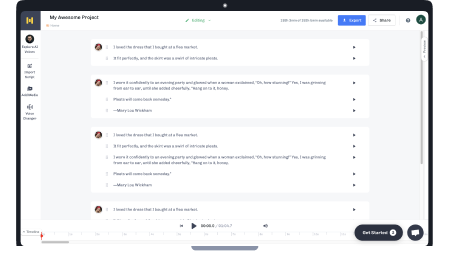What is Overdubbing: A Guide to Layering Sound and Building Rich Audio Tracks

Have you ever wondered why the song 'My Heart Will Go On…' from Titanic stays in our hearts forever? Or 'Beat It' by Michael Jackson or 'Shape of You' by Ed Sheeran?
It's because all these songs have a magic to it. And producing high-quality music is no small feat. You need to work on it for years to get it exactly as you need. But sometimes, your tracks may feel like they are missing that extra spark. This lack of depth can throw your music off the rails and fail to connect with the audience.
What can you do to address this issue? How can you rework the tracks and add new performances that make audiences fall in love with you? The answer is overdubbing, and we discuss everything you need to know about it in this blog post.
Let's get started.
What Is Overdubbing?
Overdubbing is a music production technique where additional layers of sound are recorded over existing basic tracks.
This process allows musicians and music producers to add vocals, instruments, or effects to already recorded tracks to create deeper, richer-sounding music. This technique is commonly used in studios and it enables precise edits of existing tracks and ensures creative freedom.
Overdubbing is a cornerstone of modern music production. It’s how artists craft complex and polished tracks with pre-recorded materials to captivate listeners and stand out in the industry.
A Brief History of Overdubbing
The roots of overdubbing can be traced back to the early days of the 1920s and 1930s. It was then music production companies started experimenting with basic multitrack recording techniques.
What really changed the game was the invention of tape recorders. Today, musicians and creators often rely on video dubbing softwares to synchronize audio layers with visuals, especially for films, podcasts, or training videos. It enabled music legends like Les Paul to reinvent music production by layering guitar solos and vocals. Even brands like The Beatles used overdubbing to create rich, deep music that captivated audiences.
Fast forward to now, advanced equipment and AI-powered tools make overdubbing simpler to create the modern music tracks that we fall in love with. This allows music creators to make perfect music without worrying about how to dub a video or original tracks for the best results.
Where and How Can You Use Overdubbing?
Overdubbing helps musicians and music producers to create top-notch and captivating music from existing material by combining multiple voices, sound effects, and recorded instruments.
Let's check out some of the most crucial use cases of overdubbing in the music industry.
Add vocal harmonies: Musicians use overdubbing to add vocal harmonies to the original vocal track. It allows them to add new tracks and ideas to make it better than a live performance.
Add more details: Music producers can add more details to a track with the help of overdubbing. Adding background vocals or ambient noises to the track makes the track livelier and helps improve the overall experience.
Creating scratch tracks: Overdubbing is often used in creating scratch tracks for video games, content creation, podcast production, etc.
Build orchestral arrangement: Cinematic composers use overdubbing to simulate a large orchestra with fewer musicians and layer individual instrumental recordings on top of each other to create a sense of a large orchestra.
Collaborative recording: If musicians are unavailable or cannot make it to the recording studio, overdubbing is often used to record their part later and layer it on the original track by music production companies.
Despite these live recording techniques used by musicians and production companies, they still face trouble capturing live performances is challenging.
This is where AI dubbing software like Murf Dub can enhance the process.
Pros and Cons of Overdubbing
Overdubbing allows musicians and music production companies to create the best music for the audience. The process has numerous benefits and limitations.
Let's explore each of the pros and cons of overdubbing here.
- Overdubbing helps musicians and music production companies fix issues when recording songs or music. It also allows musicians more control over their production.
- Overdubbing enables musicians to address issues like noise bleed. Instruments that cause such issues can be captured in isolation, and the sound can be added later using the overdub process.
- Overdubbing allows the performers to record their parts at their convenience and as per their individual schedules. It helps complete the project faster as it makes scheduling easier.
- Overdubbing allows artists and production companies to stack multiple audio layers, like multiple voices, instruments, effects, etc., on a single track to enrich the final mix with depth and character.
- Overdubbing helps upcoming musicians experiment with their craft. For example, if you are a guitarist, you can record multiple guitar parts with overdubbing to create a deep, emotional music piece.
- Sometimes, a song calls for a unique instrument that may not be available with the band. In such cases, you can record the instrument separately and use overdubbing to add it to the original track.
Although overdubbing offers plenty of benefits, it is also plagued by limitations. Let's look at a few of them here.
- Using overdubbing may make the song feel artificial and engineered instead of natural and organic.
- Failing to invest enough time in producing accurate overdubbing may lead to timing or synchronization issues.
- Overdubbing may not produce the quality you expect without the right studio equipment or digital audio workstations.
Tips for Successful Overdubbing
Producing top-notch and endearing music with overdubbing is often easier said than done. It takes a lot of effort and care for musicians or studios to achieve the desired results.
Here are a few tips to help you transform overdubbing for better quality.
- Always start with a solid, energetic original track having excellent timing and clarity. It will help you get an exceptional music output as you need to layer tracks over tracks upon this original one.
- Plan your overdubbing process and figure out which elements to overdub, such as vocals, harmonies, chorus, instruments, etc., to create the right depth for each track and a holistic musical experience for the audience.
- Break your overdubbing process into small parts. These short overdubs will help you focus on one section at a time for better precision and efficiency.
- Experiment with different layers within the same song, similar to how audio dubbing adds depth in film and media, to get the best outputs. You can add new soundtracks to the original one to make it unique and more nuanced than the original vision with experimentation.
- Keep your layering in control, as excessive layering can compromise the quality and emotional beats of the song. It may also clutter the mix and make the track lose its impact.
In addition to using these tips, you can also choose a high-quality AI-powered dubbing platform like Murf AI for the best results.
Use Murf AI to Help Improve Audio Recording Process

Overdubbing is a handy method for musicians and singers to create exceptional music and songs. Yet, technical challenges can be a little overwhelming for many singers. But you can produce and overdub music with AI-powered audio and video dubbing software like Murf AI.
It allows you to clone voices instantly, control pronunciation better, and ensure enterprise-grade security for your music production. It has an easy-to-use audio interface and powerful overdubbing features in place to help create music faster.
According to Goldman Sachs (2025), global music revenues were $105B in 2024 and are projected to approach $200B by 2035. As new musicians and fresh ideas continue to shape the industry, traditional methods like overdubbing remain essential.
However, the real opportunity lies in embracing AI-powered tools such as Murf AI. The Generative AI in music market, estimated at $2.9 billion in 2025, is gaining momentum and reshaping how creators produce and experiment with sound.

Frequently Asked Questions
Is it possible to improve existing recorded performance with overdubbing?
.svg)
Yes, you can improve your recorded live performance with overdubbing. re-record specific sections, like a missed note, double the track, add harmonies, etc., to improve the existing track. Overdubbing also allows you to fill gaps in your recorded performance and ensure better flow.
What is the difference between overdubbing and double-tracking?
.svg)
Both are methods used in audio recording. Overdubbing is the process of adding new parts or tracks to an existing track to improve it or complete the production. On the other hand, double-tracking is duplicating or recording the same performance to enrich the existing recording.
How can I avoid losing the energy of a performance when overdubbing?
.svg)
One of the most important things to do is start with a great track having strong energy and emotion, which will help you build up overdubbing for the next tracks. Another way is to reduce the number of overdubbing layers by pairing recording a set of different instruments together.
Is overdubbing only for professional recording studios?
.svg)
No, overdubbing is not just for professional recording studios. You can use dubbing AI tools like Murf AI to work with diverse recorded sounds and overdub the same to add new layers, musical instruments, and harmonies to improve it.
Are there any legal considerations when using overdubbing in music production?
.svg)
No, there are no legal considerations when overdubbing. However, ensure you have IP rights to the tracks you use for overdubbing if the music is for commercial use.
Are multitrack recording and overdubbing the same?
.svg)
No, multitrack recording and overdubbing are not the same. In multitrack recording, different sound sources are recorded in different tracks. However, overdubbing is the process of recording additional tracks over an existing recording.
Who are some of the famous musicians who use overdubbing?
.svg)
Taylor Swift, Les Paul, The Beatles, etc., are some of the famous musicians and bands that have used overdubbing to make their songs more special and impactful for their audiences.
Why do people overdub?
.svg)
Musicians overdub to add depth and variety to their tracks. It allows them to fix mistakes, experiment with new sounds, or add harmonies that might not be possible during a live recording. For example, a guitarist can record the main rhythm first and then overdub a solo without needing extra band members. This process gives artists more creative control and flexibility to make their music sound fuller and more polished.
What is an example of overdubbing?
.svg)
A classic example of overdubbing is when The Beatles recorded multiple layers of vocals and instruments in songs like Sgt. Pepper’s Lonely Hearts Club Band. Another well-known case is when Michael Jackson’s producers layered his background vocals in Billie Jean to give the song its rich, textured sound. In both cases, overdubbing helped create tracks that felt larger than life and continue to stand out decades later.














